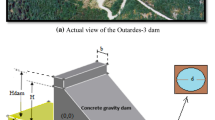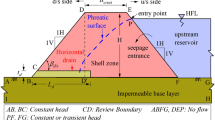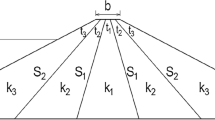Abstract
The seepage beneath a concrete dam causes an upward force acting to the dam foundation, known as uplift. Previous literatures show that implementation of drainage wells in gravity dam foundations causes a reduction in uplift forces. The main aim of these wells is to drain excess seepage flow bypassed from the cutoff wall and to reduce the uplift force. The location of the drains in the foundation plays a key role in reducing the pressure. In the present study, effect of the location of drain pipes from the upstream face of the dam (s), space among them (n) and drain’s diameter (d) in uplift force reduction is investigated. The processes of the study have been performed by the Seep/w software based on the finite element method. Results show that the use of a drain system reduced the uplift forces developed beneath the floor of the structure. If the drain is located close to the face of the dam, it may not be effective in reducing the uplift. On the other hand, shifting it too much away from the upstream face of the dam will lead to increased total uplift. It is, therefore, desirable to find out the location of the drain such that the total uplift is optimum. Optimum location of the vertical drains is not fixed, and by increasing vertical drains distances from each other and also decreasing drain diameter, optimum location would be shifted to the downstream. For example introduction of system of pipe drains to the floor of gravity dams reduced the uplift force acting on the floor by up to 80% for d/l = 0.0004, n/l = 0.024 and s/l = 0.08. This reduction in uplift becomes up to 65% for d/l = 0.0004, n/l = 0.048 and s/l = 0.12. The best location of the drain is such that the total uplift is minimum and this is presented in both design charts and algebraic equations in this study.















Similar content being viewed by others
References
Abd El-Razek M (1995) Optimal numbers and positions of the relief valves in lined canals. Alex Eng J 34(5):375–384
Ahmed A, McLoughlin S, Johnston H (2014) 3D analysis of seepage under hydraulic structures with intermediate filters. J Hydraul Eng. doi:10.1061/(ASCE)HY.1943-7900.0000944,06014019
Bernard A, Tissa I, Douglas I, Howard B (1989) Estimation of uplift in cracks in older concrete gravity dams: effect of head losses in drain pipes on uplift. J Energy Eng, ASCE 115(1):39–46
Bernstone C, Westberg M, Jeppsson J (2009) Structural assessment of a concrete dam based on uplift pressure monitoring. J Geotech Geoenviron Eng. doi:10.1061/(ASCE)1090-0241(2009)135:1(133),133-142
Casagrande A (1961) First rankine lecture: control of seepage through foundations and abutment of dams. Geo technique, London, pp 159–180
Chawla A, Kumar A (1985) Avarage uplift computation for hollow gravity dams. J Hydraul Eng. doi:10.1061/(ASCE)0733-9429(1985)111:3(455),455-466
Chawla A, Thakur R, Akhleash K (1990) Optimum location of drain in concrete dams. J Energy Eng, ASCE 116(7):930–943
Chen Y, Zhou C, Zheng H (2008) A numerical solution to seepage problems with complex drainage systems. Comput Geotech 35(2008):383–393
Dewey RR, Reich RW, Saouma VE (1994) Uplift modeling for fracture mechanics analysis of concrete dams. J Struct Eng, ASCE 120(10):3025–3044
Federal Energy Regulatory Commission (FERC) (1991) Engineering guidelines for the evaluation of hydropower projects Tech Rep Office of Hydropower Licensing. Federal Energy Regulatory Commission, Washington
Geo-Slope (2007) Version 7.1.0 User manual, Geo Slope International, Calgary
Goodman RE, Bernard A, Sitar N (1983) Uplift pressure in crack below dam. J Energy Eng, ASCE 109(4):207–221
Jain A, Reddi L (2011) Finite-depth seepage below flat aprons with equal end cutoffs. J Hydraul Eng. doi:10.1061/(ASCE)HY.1943-7900.0000459,1659-1667
Mansuri B, Salmasi F, Oghati B (2014) Effect of location and angle of cutoff wall on uplift pressure in diversion dam. Geotech Geol Eng 32:1165–1173. doi:10.1007/s10706-014-9774-3
Nasr RI, Zeydan BA, Bakry MF, Saloom MS (2003) Uplift pressure relief on lined canals using tile drains. Alex Eng J 42(4):497–507
Raymond R, Ronald W, Victor E (1994) Uplift modeling for fracture mechanics analysis of concrete dams. J Structural Eng, ASCE 120(10):3025–3044
SPSS (Version 22), Statistical package for social science (SPSS) software version 22
U.S. Bureau of Reclamations (1976) Design of gravity dams. A Water Resources Technical Publication, Department of Interior, Denver
Woyshner MR, Yanful EK (1995) Modeling and field measurements of water percolation through an experimental soil cover on mine tailings. Can Geotech J 32:601–609
Author information
Authors and Affiliations
Corresponding author
Rights and permissions
About this article
Cite this article
Nourani, B., Salmasi, F., Abbaspour, A. et al. Numerical Investigation of the Optimum Location for Vertical Drains in Gravity Dams. Geotech Geol Eng 35, 799–808 (2017). https://doi.org/10.1007/s10706-016-0144-1
Received:
Accepted:
Published:
Issue Date:
DOI: https://doi.org/10.1007/s10706-016-0144-1




